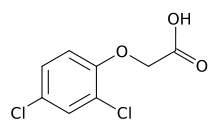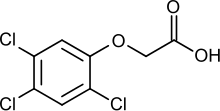Agent Orange
![]()
This article is about the defoliant. For other meanings, see Agent Orange (disambiguation).
Agent Orange is the military name for a chemical defoliant used extensively by the United States to defoliate forests and destroy crops during the Vietnam War and the Laotian Civil War. U.S. forces first used it in January 1965 as part of Operation Ranch Hand to make it difficult for the enemy guerrilla movement FNL ("Viet Cong") to camouflage through the dense jungle and disrupt their food supply. It was sprayed over large areas by planes or helicopters. Since the herbicide was contaminated with 2,3,7,8-tetrachlorodibenzodioxin (TCDD) due to its production, many hundreds of thousands of inhabitants of the affected areas and up to two hundred thousand US soldiers fell ill.
TCDD is the most toxic of the dioxins. Among other things, it has a fetotoxic (teratogenic) effect, i.e. it damages the unborn child in the womb, and is very persistent, i.e. it remains in the environment for a long time. The persistent exposure of the Vietnamese population to dioxin has been linked to a drastically increased incidence of severe malformations in children, cancers, immune deficiencies and a large number of other diseases. In 2002, the Red Cross estimated that about one million Vietnamese suffered health damage from late effects of Agent Orange, including about 100,000 children with congenital malformations. While injured former US soldiers were financially compensated by the manufacturing companies at the time after legal disputes, Vietnamese victims have not received any compensation to date. A corresponding class action lawsuit in the USA was dismissed in 2005, as the use of Agent Orange was "not chemical warfare" and therefore not a violation of international law.
The name comes from the orange stripes with which the corresponding barrels were marked. The English word agent here means "agent" or "active ingredient". Other, less well-known herbicides are Agent Blue, Agent Purple, Agent Green, Agent Pink and Agent White. The international CAS identification number of Agent Orange is 39277-47-9.
(1,4)dioxine_200.svg.png)
Structural formula of 2,3,7,8-TCDD, which was present as an impurity in Agent Orange and is considered to be the cause of the health damage.
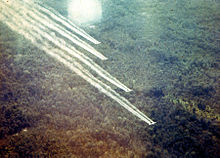
Four U.S. Fairchild C-123 transport aircraft - converted to crop dusters - during "Operation Ranch Hand" in Vietnam.
Use and manufacturer
Between 1962 and 1971, more than 6,000 sorties with various defoliants were conducted by the U.S. Air Force in the Vietnam War during Operation Ranch Hand, authorized by John F. Kennedy in 1961. Agent Orange was sprayed from planes and helicopters from January 1965 to April 1970. The
first area-wide deployment took place on 7 February 1967. The aim was to defoliate forests in order to uncover hiding places and supply routes of the enemy (Ho Chi Minh Trail) and, on the other hand, to expand own military bases and airfields in the dense jungle. In addition, arable land was sprayed to deprive the enemy of food.
Agent Orange was manufactured and supplied by, among others, the US companies Dow Chemical and Mobay, a joint venture between Monsanto and Bayer AG. Due to the enormous demand, there were supply difficulties. Intermediates were also supplied by the German company Boehringer Ingelheim and the Czechoslovakian company Spolana. According to a 1991 article in the news magazine Der Spiegel, Boehringer Ingelheim supplied 720 tons of trichlorophenolate lye to Dow Chemical in 1967. The use of Agent Orange reached its peak in 1967 and 1968.
The bulk of Agent Orange contained a mixture of the n-butyl esters of 2,4,5-trichlorophenoxyacetic acid (2,4,5-T) and 2,4-dichlorophenoxyacetic acid (2,4-D) in equal proportions. The active ingredient content was 1033 grams per liter, expressed as ester-free 2,4,5-T and 2,4-D. Probably starting in 1968, "Agent Orange II" was also used, which consisted of a 50:50 mixture of the iso-octyl ester of 2,4,5-T and the n-butyl ester of 2,4-D. It had an active ingredient content of 910 grams per liter. 3,591,000 liters of "Agent Orange II" were delivered to Vietnam. US forces sprayed a total of 45,677,937 liters of Agent Orange. If the other herbicides are added, the number almost doubles to 80 million liters. By 1971, this had defoliated nearly a quarter of Vietnam.
A mixture called "Modified Orange", which also contained the active ingredient picloram, was only used on a trial basis.
The last spray plane carrying Agent Orange took off on January 7, 1971. In 1973, the U.S. Air Force still had stocks of 2,338,900 gallons (8,853,672 liters) with an acquisition value of $16,540,000. Since a restriction on the use of 2,4,5-T was issued in the U.S. in 1970 and upheld by the EPA in 1971, consideration was given to selling the excess Agent Orange as herbicide in South America. Stockpiles of Agent Orange were stored on Johnston Island and at the Naval Construction Battalion Center in Gulfport, Mississippi. Only now were dioxin levels beginning to be determined. Dioxin concentrations varied widely from drum to drum. In Gulfport, 28 samples were found to have TCDD concentrations ranging from 6.2 to 14.3 ppm, with a mean of 13.25 ppm. In another study, TCDD levels ranged from 0.05 to 13.3 ppm. From this, a mean value of 2.99 ppm (mgL-1) was derived. For 200 samples from the Johnston Island repository, the mean value for Agent Orange was 1.91 ppm ± 20% TCDD. This did not include four samples with the highest levels (17, 22, 33, and 47 ppm) because they may have been Agent Purple. The remaining stocks were incinerated on the high seas aboard the incinerator ship Vulcanus in 1977. Estimates of the amounts of dioxin released in Vietnam in association with the herbicides range from 106 to over 366 kg.

Map of contaminated areas in South Vietnam. Green: defoliation, red: crop destruction.
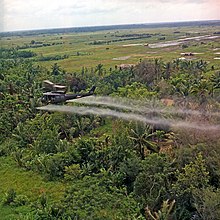
Defoliant spraying in the Mekong Delta in July 1969 by a Bell UH-1 helicopter.
Damage and problems until today
The main cause of the immense damage to humans and nature is the by-product TCDD, which is formed during the production of trichlorophenoxyacetic acid. The long-lived TCDD is formed during synthesis between 300 and 600 degrees Celsius. It is the most toxic of the 300 or so dioxins (known as the "Seveso toxin" since the 1976 Seveso disaster in Italy). Even the smallest amounts can cause severe organ damage and cancer. It disrupts hormonal signalling pathways and causes severe malformations in children.
According to the Vietnamese Association of Victims of Agent Orange, more than three million victims of Agent Orange suffer from late effects of Agent Orange, especially deformities such as cleft lip and palate and immune deficiencies. Many newborns are born with severe deformities even three generations after the use of Agent Orange. Cancer is also one of the late effects. So far, there is a lack of studies on the connection between exposure to Agent Orange and the development of tumours, but dioxin is known to be carcinogenic.
Agricultural scientists from Illinois and Iowa predicted in early 2019 in the scientific journal "Open Journal of Soil Science" that Vietnam would suffer from the late effects for decades to come. On the surface, TCDD decays in one to three years; in soil and in river and ocean sediments, it can persist for more than 100 years. TCDD spread via rivers, wind and soil erosion during the monsoon season and entered food chains.
Since the 'Pivot to Asia' announced by US President Obama, the US needs new allies against China. Therefore, since 2012, the US government has been involved in the soil decontamination around the former US base Da Nang, which was a main distribution point for Agent Orange. Forty-three million dollars have been made available for this purpose. In 2016, the US Agency for International Development (USAID) estimated that for contamination in the megacity of Bien Hoa alone, a comprehensive dioxin cleanup would cost 126 to 600 million US dollars.
Furthermore, severely malformed and sick children are born. Most of the victims cannot receive adequate medical care, if at all. Vietnam's government invests mainly in the economic development of the country. Individuals are building homes and health stations for victims of Agent Orange with donations they have collected themselves. In 1998, the Village of Friendship, built with the help of US war veterans, was opened as a treatment centre for victims of the defoliant.
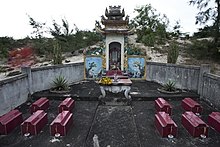
The Đỗ Đức Địu family lost 12 of 15 children to premature and stillbirths, possibly a result of "Agent Orange", family grave.

A Vietnamese professor from the Tu Du Hospital for Obstetrics and Gynecology with a group of children, some of whom are severely handicapped. The child in the foreground, for example, has no eyes. The boy on the far left (back) has only one leg.
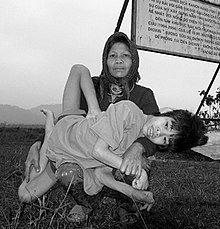
A 14-year-old boy with severe mental and physical disabilities whose deformities are attributed to his parents' exposure to Agent Orange.
Search within the encyclopedia
